The Micro Artist Studio
The Micro Artist Studio at Seiko Epson Corporation’s Shiojiri plant is one of the four main facilities which together make up the Shinshu Toki-no-Waza Studio, alongside the Dial Workshop, the Takumi (Mastery) Studio and the Case & Jewelry Studio.
The Micro Artist Studio was established in the year 2000 for the purpose of passing on the skills required in the watchmaking craft to the next generation. As demand for high grade, traditional watches grows, Seiko decided to train a new generation of skilled craftsmen in the technologies and artistic crafts that will preserve world-class Japanese watchmaking and create new timepieces that will further increase Seiko’s growing reputation as a leading manufacture.
Technical experts from an array of different fields have gathered at the Micro Artist Studio, and since 2004 they have applied their many and varied talents to producing exclusive watches. The studio is known for having created the Spring Drive Minute Repeater and Sonnerie and the two Eichi watches, all of which have been widely praised for their craftsmanship and rare beauty.
Seiko’s craft and the technique it embodies have not only cultivated successors to its legacy, but also inspired passion by expanding horizons with the Eichi II. The Micro Artist Studio will continue its mission to develop even greater craft techniques.
Yoshifusa Nakazawa joined Suwa Seikosha in 1978. After receiving instruction at the company’s technical training center for three years, he was crowned champion in the Watch Assembly and Repair Section of the 1981 World Skills Olympics held in Atlanta, USA. From there he went on to develop his career in assembling luxury watches. From 1991 to 1997, Mr. Nakazawa worked to cultivate talent and improve manufacturing procedures abroad. He later returned to Seiko Epson in Japan and worked as a foreman on the assembly line. In 2005, Mr. Nakazawa officially joined the Micro Artist Studio to take charge of complication watch assembly.
Mr. Nakazawa’s motto is ‘Thoroughly execute the basics of assembly,’ and his methods are highly regarded for their precision and exquisite finish. He is set on using his watchmaking experience—the know-how, passion, satisfaction, and sincerity he feels toward his work—and passing it on to the next generation of watchmakers as he continues to demonstrate his superior skill and leadership.
-
Polishing
All the major components in the watches produced by the Micro Artist Studio are made in Seiko’s Shiojiri facility and are sent to the Studio for polishing.
Above all, the bridge’s corners and the bevel around the ruby bearings must be polished to perfection to ensure that light striking the round edge conveys the metal’s natural beauty without producing distortion. The fine polishing required to achieve this level of finishing can only be realized through years of experience and precise craftsmanship. Other parts, such as the tips of the pivots visible through the ruby bearings, are also polished. As these tips vary in thickness, great skill is required to produce a beautiful shine.
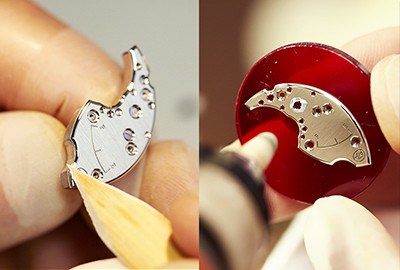 +
+
-
Firing porcelain dials
The base materials for the porcelain dials are manufactured in a factory also located in Nagano Prefecture. After production, the glazed materials are shipped to the Micro Artist Studio. The materials are made of 100% alundum and yield a striking difference in whiteness when compared to traditional porcelain dials. At the Micro Artist Studio, the porcelain parts are painted and fired. This collaborative effort makes use of the Micro Artist Studio’s know-how to produce an original soft texture and even higher quality finished product.
The dial of Eichi II is four mm larger than that of its predecessor so that the time is easier to read and so that the beauty of the porcelain is all the more striking.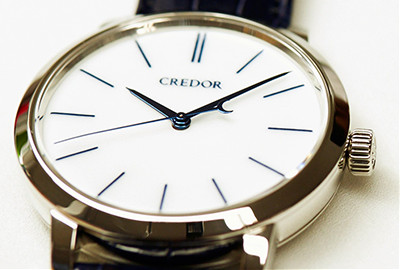 +
+
-
Hand-painting the logo and indexes
The logo and indexes are hand-painted to further elaborate the sense of warmth peculiar to porcelain dials. The resident painter at the Micro Artist Studio spent three years with ceramics makers renowned throughout Japan, where he received rigorous training. The painter takes special care over every aspect of the painting process, right down to mixing colors and selecting brushes. Strong focus and technical ability are needed to complete even just one piece a day.
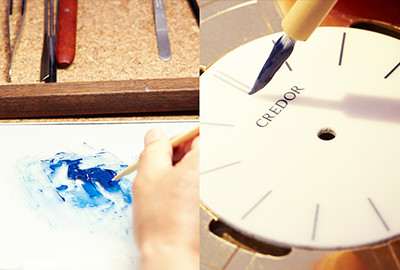 +
+
-
Bluing
In this process, the hour, minute, and second hands are processed into a blue color that gives them a unique appearance. Known as “tempered blue hands,” they are created through a process of about twenty steps. As heat is applied to the mirror-surfaced parts, the surface color changes from brown to blue. As this iconic blue coloration only occurs at a specific moment, removing parts from the flame at exactly the right moment requires expert skill. This step exploits the natural phenomenon of color changes through variation in temperature and humidity to produce a deep and consistent blue. In the Eichi II, the screws fastened to the bridge are also blued.
*The watch hand depicted in the picture does not belong to the Eichi II.
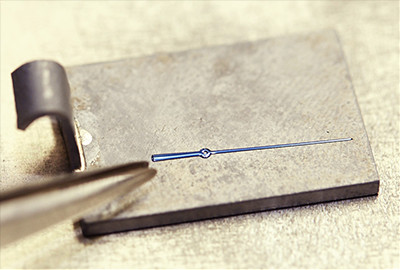 +
+
-
Assembly
The precisely crafted and beautiful parts are skillfully assembled by Mr. Nakazawa using processes designed in the Micro Artist Studio itself. While this assemby may seem straightforward at first glance, the ultimate sense of simplicity achieved here is actually the result of practiced, high-level skill that is absolutely intolerant of waste or imperfection. Mr. Nakazawa's hands give life to the assembled parts, turning them into watches of astonishing precision.
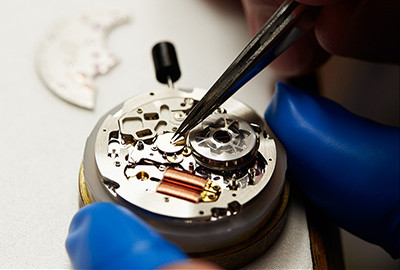 +
+
-
Casing
In Eichi II, the power reserve indicator has been moved to the back side of the dial, giving the watch face a clean, serene and quality feel. While the back plate of the 2008 Eichi consisted of three bridges, for Eichi II, this has been reduced to two. The change evokes a better sense of balance, with the power reserve indicator on one bridge and the Credor logo inscribed on the other.
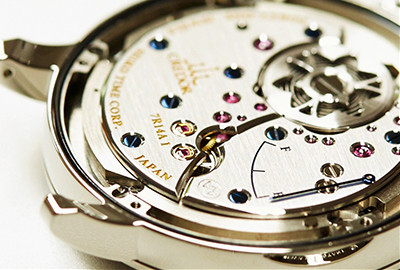 +
+
-
Watchmaking Tools
The tools used in watchmaking are essential items for expressing a master’s skill and are each personally customized by technical experts to their liking. In polishing, for example, the dried stalk of the gentian plant is used for its optimum softness as well as its capacity to hold abrasive compounds and provide an even finish. These stalks need to be cut to the appropriate length before they can be used and are difficult to obtain in Japan. However, investigations led the Micro Artist Studio to a medical university in Hokkaido which had been cultivating the plants for use as medicine, and now the Studio sources all its gentian from Hokkaido cultivars.
In addition, the brushes used to paint the logo and indexes are sourced from brush makers in Hiroshima known for their quality cosmetics brushes. Our painting expert visits the company himself and carefully picks only the finest brushes.


